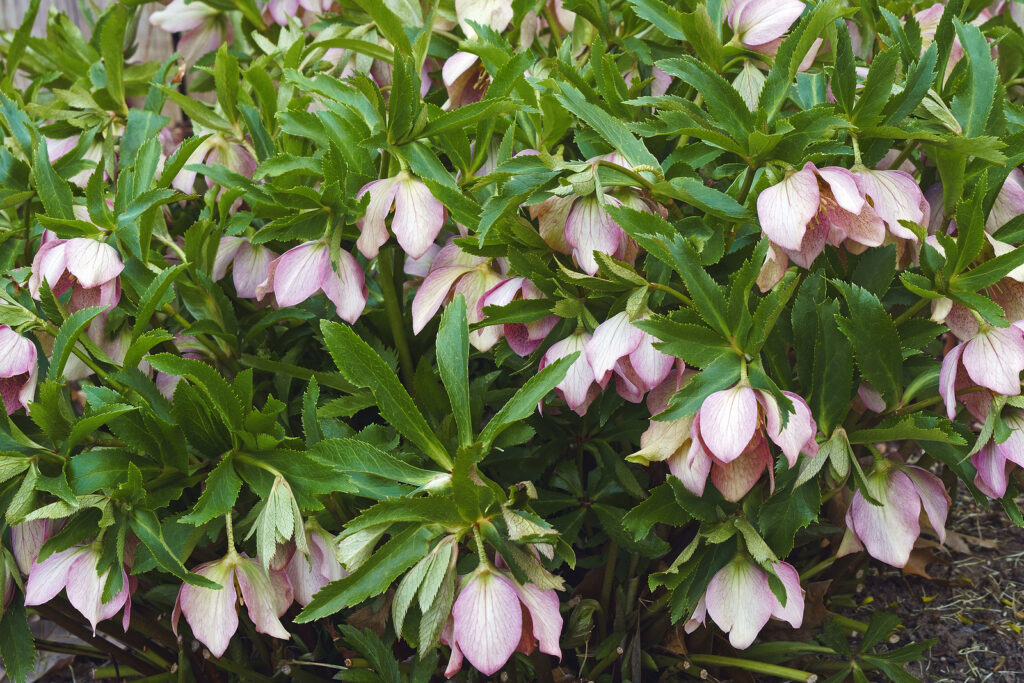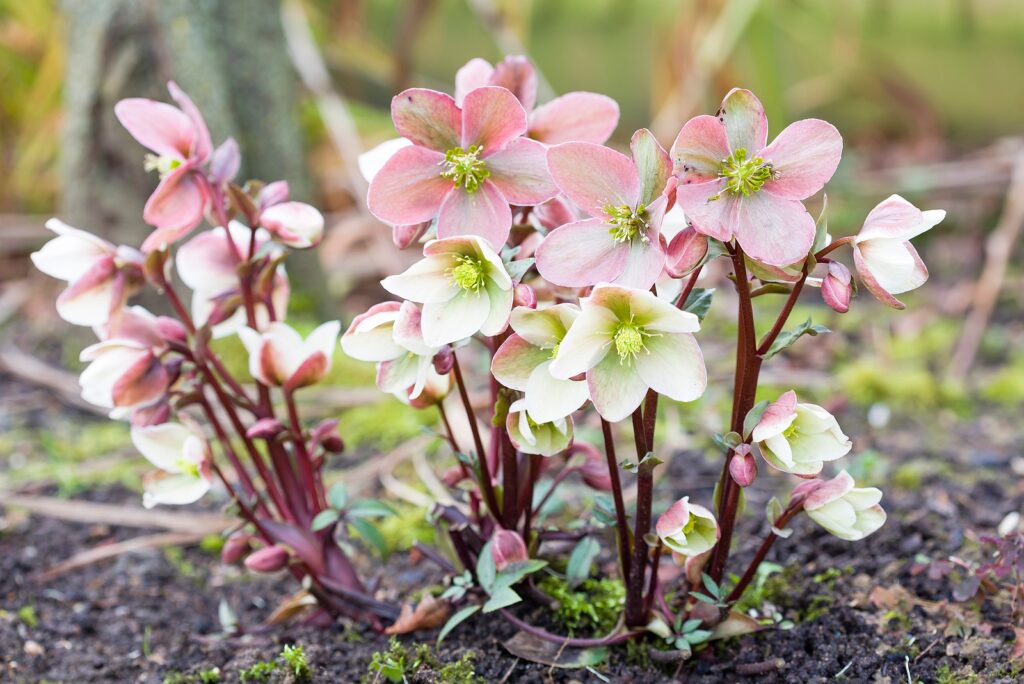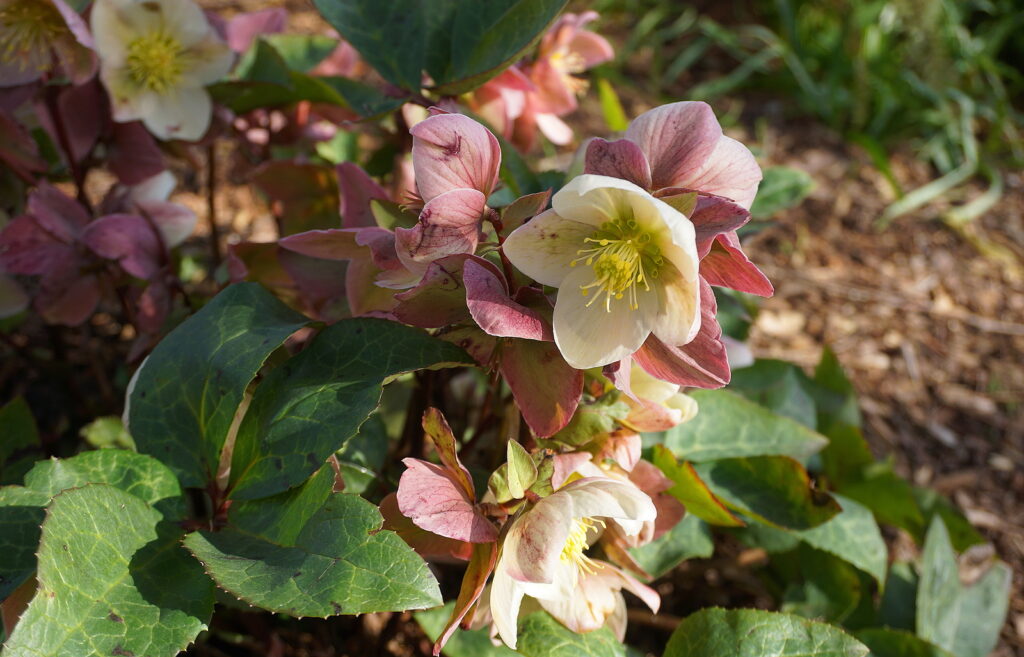Helleborus–commonly called Lenten rose or Christmas rose depending on the cultivar–has nodding purple, white, or pink cup-shaped flowers in winter or early spring. Flowers are born singly or in clustered.
Helleborus are long-lived perennials. They bloom in late winter or early spring. The showy parts of the flowers are not true petals but petal-like sepals which hold on the plant and remain attractive for 2 to 4 months. The dark green, leathery leaves are divided into lobes or leaflets and are usually toothed.
Mass Helleborus under high-branching trees on north or east side of walls or in beds. Helleborus doe not like being moved so situate them where they can remain for several years.

Get to know Helleborus
- Plant type: Perennial
- Growing Zones and range: 3-9
- Hardiness: Hardy to -5°F (-20°C); plants will fail in extreme heat or drought
- Height and width: 14 to 18 inches (35-45cm) tall; 18 to 24 inches (45-61cm) wide
- Foliage: Basal clumps of long-stalked leaves are lobed or fully divided into leaflets; they are generally toothed, leathery, and light to dark green.
- Flowers: Large, bell-shaped blossoms borne singly or in clusters, centered with many stamens.
- Flower colors: Maroon, pink, green, white
- Bloom time: mid- or late winter
- Uses: Under trees or in beds and borders where they are somewhat shaded in summer.
- Uses: Shade, winter interest, beneath trees, woodland gardens
- Companions: Use in plantings with azaleas, fatsia, pieris, rhododendrons, skimmia, and ferns.
- Common name: Christmas Rose, Lenten Rose
- Botanical name: Helleborus species and hybrids
- Family: Ranunculaceae
- Origin: Southern Europe to Western Asia
Where to plant Helleborus
- Plant Helleborus in pa5tion shade; protect plants from the hot afternoon sun.
- Plant Helleborus in humus-rich, well-drained soil. Helleborus prefers ample water. Add aged compost to the planting bed ahead of planting.
Helleborus uses and companions
- Helleborus is an excellent year-round plant in shade gardens.
- Helleborus are effective when grown in groups in a mixed or shrub border.
- Good garden companions for Helleborus include Brunnera macrophylla, Dicentra, Digitalis, Doronicum, Epimedium, Polygonatum, Thalictrum.

When to plant Helleborus
- Set established Helleborus plants in the garden in spring
Planting and spacing Helleborus
- Space Helleborus 18 to 24 inches apart.
How to water and feed Helleborus
- Keep Helleborus well-watered.
- Fertilize Helleborus with an all-purpose fertilizer before blooming.

Helleborus care
- Mulch around Helleborus to conserve soil moisture.
- Remove spent blooms and trim away worm foliage.
- Helleborus will spread in good growing situations.
- Helleborus is commonly pest and disease-free.
Helleborus pests and diseases
- Helleborus is susceptible to slugs, snails, aphids, leaf spot, and black rot.
Helleborus propagation
- Sow seed in containers in a cold frame when seeds are ripe; named cultivars do not come true. Helleborus seeds can take 6 to as long as 18 months to germinate.
- A good way to increase plantings is to save volunteer seedlings and move them to a new location.
- Divide all species and named cultivars after flowering, in early spring.

Helleborus varieties to grow
- Helleborus argutifolius, Corsican hellebore: Grows to 3 feet tall; pale blue-green leaves; clusters of large light chartreuse flowers among upper leaves; blooms from autumn to late winter; flowers remain attractive until summer.
- H. foetidus: Grows to 18 inches tall; leathery green leaves; 1-inch flowers are light green with purplish margin in large clusters.
- H. niger, called Christmas rose: Grows to 18 inches tall; dark green leaves divided into leaflets; white or greenish-white flowers; blooms mid-to-late winter and is hardy in Zones 3-8.
- H. orientalis, also called Lenten rose: Grows to 18 inches tall; white, greenish, purplish, or rose flowers often splashed with deep purple; blooms in late winter; H. niger, called Christmas rose, blooms mid-to late winter and is hardy in Zones 3-8. Cultivar ‘Royal Heritage’ has single and double flowers that range from cream to pastel pink.















